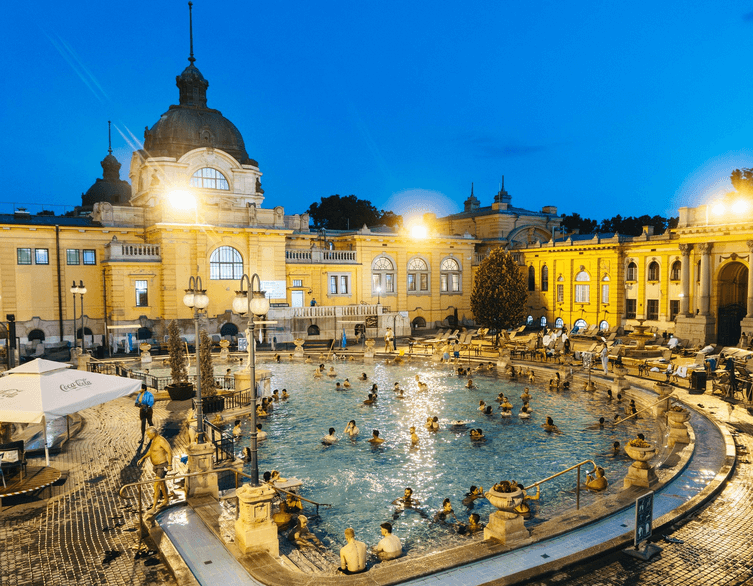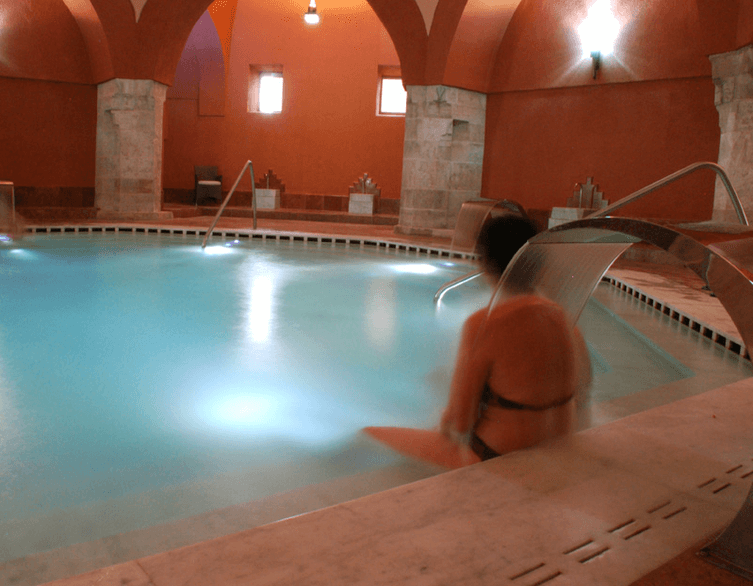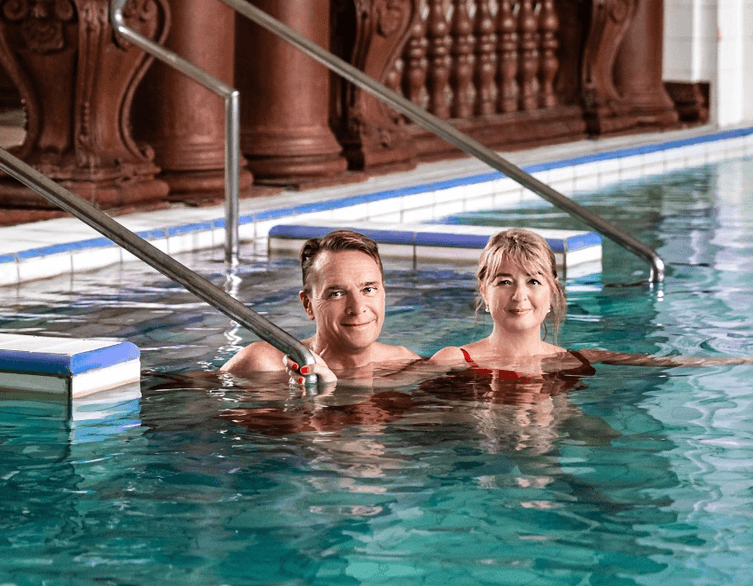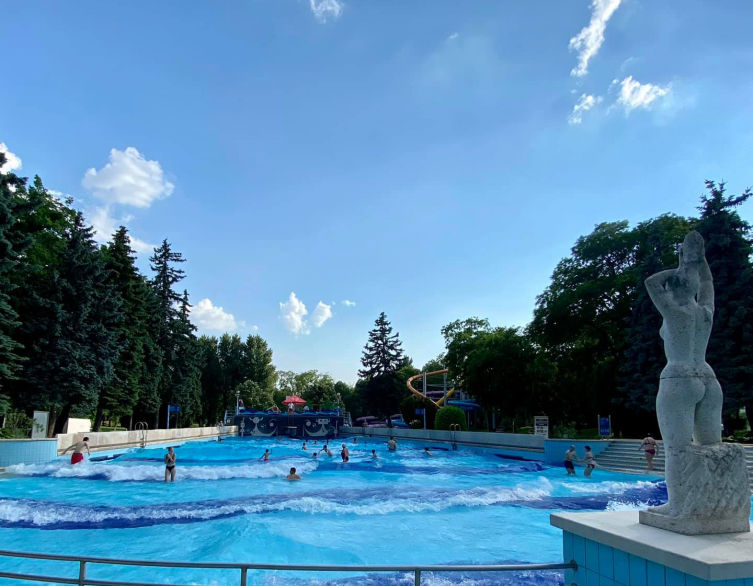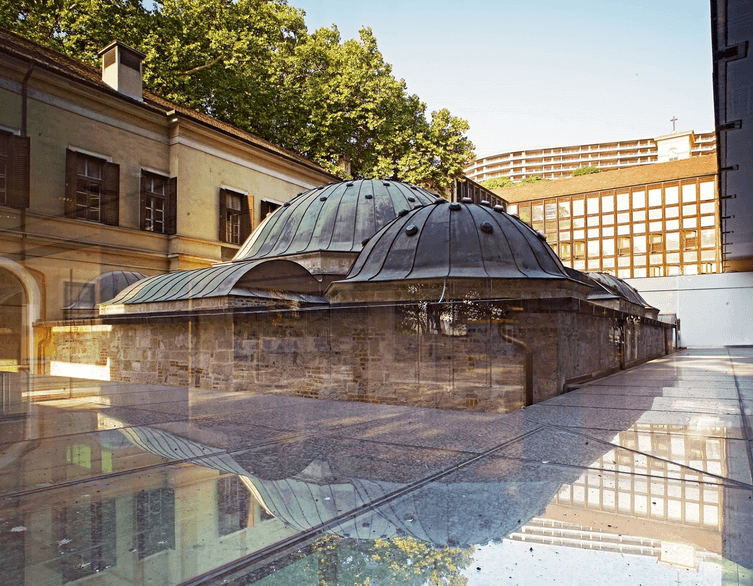Lukács Bath: From The Ancient Romans To The Modern Day Thermal Bath Culture
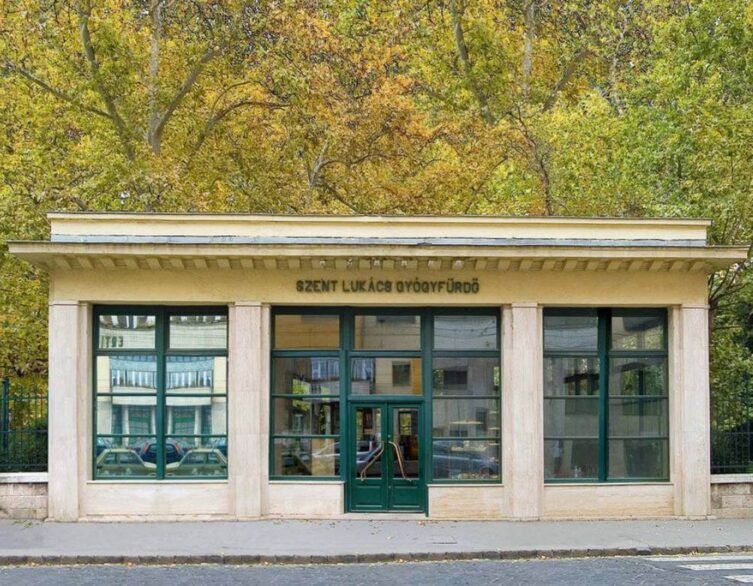
The Lukács Bath is one of the oldest and most renowned thermal baths in Budapest, Hungary. Located in the Buda side of the city, near the Danube River, this historic spa has been providing therapeutic and recreational services for centuries. The bath is famous for its healing thermal waters, stunning architecture, and rich cultural significance.
History
Nestled in the heart of Budapest, the Lukács Bath is one of the city’s oldest and most renowned thermal baths. With a history spanning over eight centuries, this iconic institution has been a haven for relaxation, healing, and social gatherings for generations of Hungarians and international visitors alike.
The story of Lukács Bath begins in the 12th century when knights of the Order of Saint John, known for their dedication to healing the sick, settled in the area. They were followed by the Orders of Rhodes and Malta, who built monasteries and baths on the site. The thermal springs that fed these baths were believed to possess miraculous healing properties, drawing people from far and wide.
During the Ottoman occupation of Hungary, the bath continued to operate, although the spring’s energy was primarily used for producing gunpowder and grinding wheat. After the reoccupation of Buda, the bath became the property of the Treasury.
In 1884, Fülöp Palotay, a local entrepreneur, purchased the bath from the Treasury, marking the beginning of a new era. Palotay embarked on a series of transformations, building a spa hotel, establishing a modern hydrotherapy department, and renovating the swimming pool. These improvements attracted people from all over the world who sought to be healed by the bath’s therapeutic waters. Many of these visitors, upon experiencing successful treatments, expressed their gratitude by placing marble tablets on the walls of the bath’s courtyard.
The drinking cure hall of the bath was built in 1937, further enhancing its reputation as a comprehensive wellness destination. In 1979, Lukács Bath became home to Budapest’s first daytime hospital, offering complex thermal bath facilities.
As the 20th century drew to a close, Lukács Bath underwent a series of renovations to keep pace with modern demands. In 1999, the open-air pools were modernized, with the underutilized mud pond being replaced by a state-of-the-art pool equipped with features such as a whirlpool corridor, underwater effervescence, neck showers, and a back massage water beam. The two swimming pools in the bath’s courtyard were also rebuilt with water filtration and circulation systems.
Today, Lukács Bath stands as a testament to Budapest’s rich thermal bath culture, offering visitors a unique blend of history, healing, and relaxation. With its centuries-old tradition of providing therapeutic treatments and its modern amenities, Lukács Bath continues to be a beloved destination for both locals and tourists, ensuring that its legacy will endure for generations to come.
Architectural Significance
The Lukács Bath showcases an eclectic mix of architectural styles, reflecting its long history and numerous renovations. It is one of the oldest baths in the city, with a history dating back to the 12th century when the Knights of the Order of Saint John settled in the area and built a monastery and bath. Over the centuries, the bath has undergone numerous transformations and renovations, resulting in its current eclectic architectural style.
One of the most striking features of the Lukács Bath is its courtyard, where visitors who have been successfully healed have placed marble tablets to express their gratitude. This unique tradition adds to the bath’s historical and cultural significance, serving as a testament to its long-standing reputation as a place of healing.
The bath’s main building, designed by architect Rezső Ray, was completed in 1921. The building’s facade combines elements of various architectural styles, including Neo-Baroque and Art Nouveau. Inside, the bath features several thermal pools, steam rooms, and saunas, each with its own unique architectural character. For example, the 40°C circular pool evokes the atmosphere of a traditional Turkish bath.
In 1937, a drinking hall was added to the complex, constructed using marble from the reception hall of the Millennium Exhibition. This addition showcases the bath’s continuous evolution and adaptation to the needs of its visitors.
The Lukács Bath also boasts an impressive outdoor area, with two swimming pools surrounded by neo-classical colonnades and a well-maintained garden. The garden features two memorial benches donated by descendants of regular bath visitors, adding to the site’s cultural heritage.
Throughout its history, the Lukács Bath has been a center of social life, attracting numerous Hungarian intellectuals, public figures, and artists. This cultural significance, combined with its architectural merits, has earned the bath a place on the tentative list of UNESCO World Heritage Sites as part of the “Thermal Spas of Budapest” nomination.
In recent years, the Lukács Bath has undergone extensive renovations to modernize its facilities while preserving its historical and architectural values. The restoration work, completed in 2013, was recognized with an ICOMOS (International Council on Monuments and Sites) award, highlighting the successful balance between conservation and adaptation to contemporary needs.
Best deals of Budapest
In conclusion, the Lukács Bath is a significant example of Budapest’s rich thermal bath culture, with a unique blend of architectural styles, a long history of healing, and a strong connection to the city’s cultural and intellectual life. Its ongoing preservation and recognition underscore its importance as a valuable heritage site for both local residents and international visitors.
Cultural Significance
The Lukács Thermal Bath in Budapest is a historic spa complex with significant cultural importance, attracting both local residents and international tourists.
Healing traditions: For centuries, people have sought out the Lukács Bath for its perceived medicinal properties. The thermal waters are rich in minerals and are believed to help with joint pain, arthritis, and other ailments. This tradition of balneotherapy (using baths for healing) is an important part of Budapest’s spa culture.
Social hub: In the late 19th and early 20th centuries, the Lukács Bath became a popular gathering spot for Budapest’s intellectual elite. Writers, artists, and other notable figures would meet at the baths to socialize, discuss ideas, and find creative inspiration. This cemented the bath’s status as a cultural institution. Throughout the 20th century, the Lukács Bath was a popular gathering place for Hungarian intellectuals, artists, and public figures. Notable patrons included composer Zoltán Kodály, writers Gyula Illyés and Tibor Déry, and filmmakers Károly Makk and Péter Bacsó. The bath served as a center for social interaction and cultural exchange, cementing its place in Budapest’s cultural heritage.
Architectural heritage: The current bath complex is an eclectic mix of architectural styles, reflecting its long history of renovations and expansions. The older parts of the building have a distinctly Neo-Baroque character, while later additions show Art Nouveau and modern influences. The Lukács Bath is a protected heritage site.
“Tablets of gratitude”: One of the Lukács Bath’s most famous features is the collection of marble tablets lining the walls of the courtyard. These tablets were placed there by visitors who believed the waters had cured their ailments, as a way of expressing gratitude. Though many were lost in World War II, the remaining tablets are a poignant reminder of the bath’s history.
Local landmark: For residents of Budapest, the Lukács Bath is a beloved institution and a source of civic pride. Many local people have fond memories of visiting the baths with family and friends. The bath complex is an integral part of the city’s identity.
In summary, the Lukács Thermal Bath is significant as a place of healing, social interaction, architectural heritage, and local pride. Its long history and enduring popularity have made it a cultural landmark in Budapest.
Provided Services
The Lukács Bath is one of Budapest’s oldest and most renowned thermal baths, offering a wide range of services for both relaxation and medical purposes. Located in the city’s 2nd district, near the Danube River, this historic spa attracts visitors from around the world who seek to experience its healing waters and unique atmosphere.
Thermal Pools and Medical Services
At the heart of the Lukács Bath are its thermal pools, filled with natural medicinal water sourced from the nearby Molnár János Cave. The water temperature ranges from 32°C to 40°C, and the pools are designed for both relaxation and medical treatments. Visitors aged 14 and above can enjoy the healing effects of the mineral-rich water, which is said to be beneficial for various conditions such as joint diseases, spinal disorders, and post-injury rehabilitation.
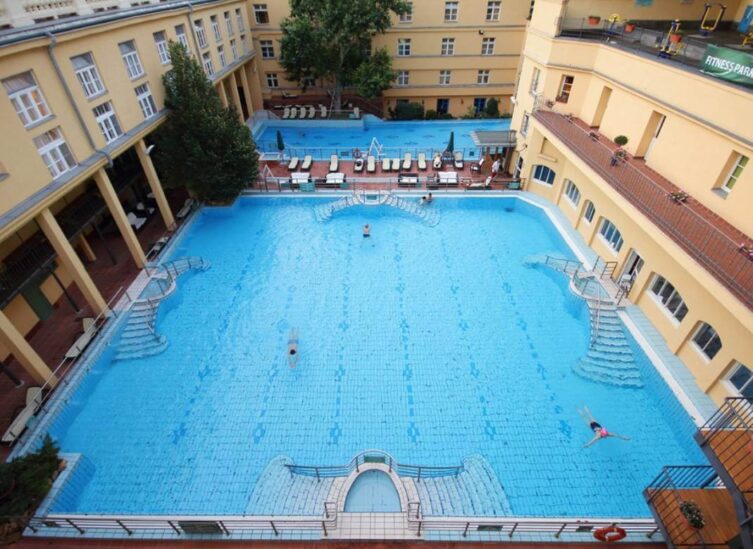
Image source: Lukács Gyógyfürdő és Uszoda
The bath also offers a range of medical services, including underwater traction, hydrotherapy, and physiotherapy. These treatments are available upon consultation with the on-site medical staff and can be particularly helpful for those recovering from injuries or managing chronic conditions.
Swimming Pools and Wellness Facilities
In addition to the thermal pools, the Lukács Bath features two swimming pools with temperatures of 22°C and 26°C. These pools are popular among locals and tourists alike, offering a refreshing escape from the city’s heat during the summer months. The swimming pools are also steeped in history, with notable figures such as the renowned composer Zoltán Kodály having been regular visitors.
The wellness facilities at the Lukács Bath include a leisure pool with a whirlpool corridor, underwater effervescence, neck showers, and a bubbling bed. There is also a cold plunge pool, a Kneipp pool for foot massages, and several saunas, including a thermal sauna, steam room, Finnish sauna, and infrared sauna. These amenities provide visitors with a variety of options for relaxation and rejuvenation.
Massage Treatments and Sauna World
For those seeking further relaxation, the Lukács Bath offers a range of massage treatments. Visitors can choose from classic massages such as aroma massage and refreshing massage, as well as premium options like the Luxury Refreshing massage and the Harmony Aroma massage. These treatments are designed to complement the thermal bath experience and promote overall well-being.
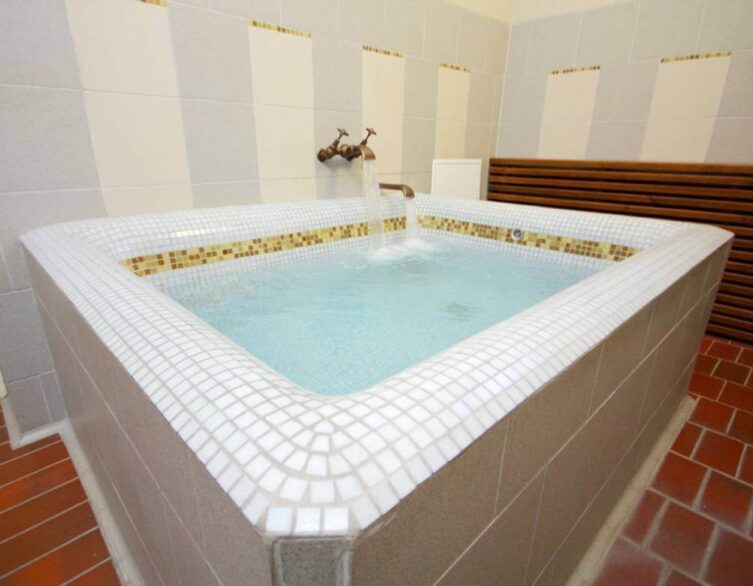
Image source: Lukács Gyógyfürdő és Uszoda
The recently renovated Sauna World is another highlight of the Lukács Bath. This dedicated area features a salt crystal sauna, aroma steam room, infrared sauna, Finnish sauna, naturist sauna, and tepidarium. The varying temperatures and humidity levels of these saunas cater to different preferences and provide numerous health benefits, such as improved circulation, detoxification, and stress relief.
Additional Amenities and Services
To ensure a comfortable and convenient experience for visitors, the Lukács Bath provides lockers and cabins for storing personal belongings. Safety deposit boxes are also available for valuables. During the summer months, guests can enjoy sunbathing on the rooftop terrace or make use of the outdoor fitness park.
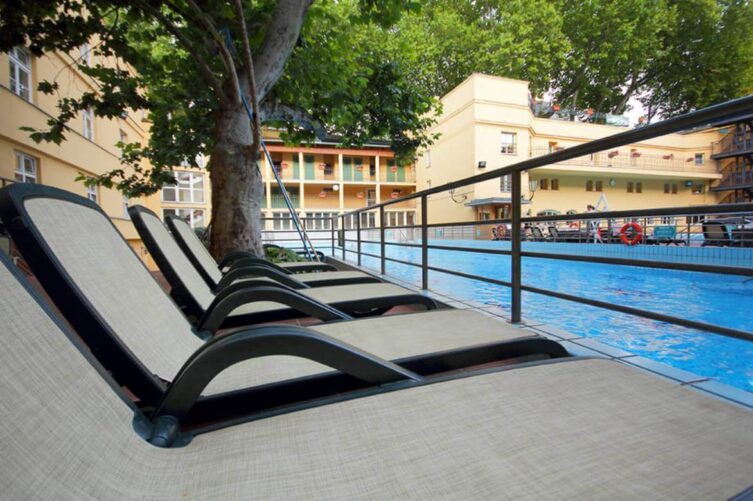
Image source: Lukács Gyógyfürdő és Uszoda
The bath also features a drinking fountain, where visitors can sample the therapeutic thermal water, which is rich in minerals such as calcium, magnesium, and fluoride. The drinking cure is believed to be beneficial for digestive issues and other health concerns.
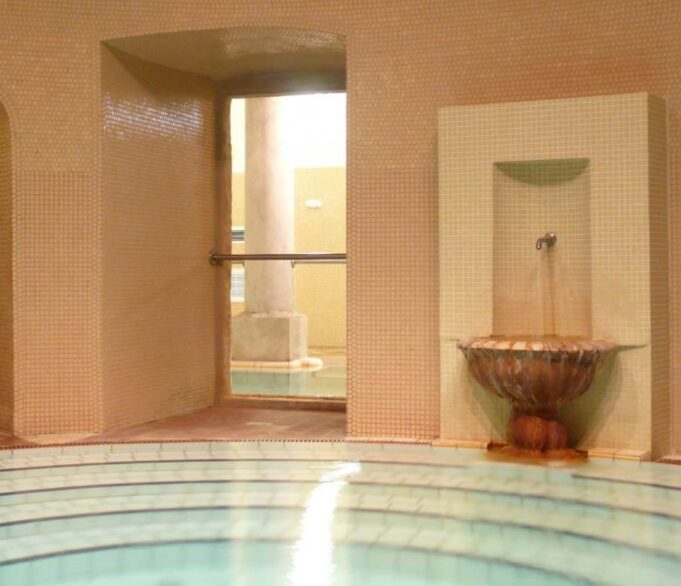
Image source: Lukács Gyógyfürdő és Uszoda
Cashless Payments While Bathing
The Lukács Bath in Budapest offers a convenient cashless payment system that allows visitors to enjoy the facilities without carrying cash or cards while bathing. Upon arrival, guests can obtain a waterproof card equipped with contactless payment technology. This card serves as a means of making purchases within the bath complex.
To set up the card, visitors can add the desired amount of money to the card at the reception desk. A minimum initial balance of 800 HUF is required for unused cards, while the minimum top-up amount for cards already in use is 100 HUF. The maximum balance allowed is 50,000 HUF. A 300 HUF deposit is held on the card, which is refunded when the undamaged card is returned.
Throughout their visit, guests can use the card to pay for various services and products within the bath, including refreshments at the bistro, massage treatments, or additional spa services. This eliminates the need to carry a wallet or cash while moving between pools, saunas, and other areas of the facility.
For added protection, guests have the option to register their card with a PIN code, which can be done through the free Festipay mobile application.
At the end of their visit, any remaining balance on the card can be refunded at the reception desk. Alternatively, regular visitors can choose to keep their balance for future visits, as the card remains valid for up to 5 years.
In conclusion, the Lukács Bath in Budapest offers a comprehensive range of services that cater to both the physical and mental well-being of its visitors. With its rich history, healing thermal waters, and modern amenities, this iconic spa continues to be a popular destination for those seeking relaxation, rejuvenation, and medical treatments in the heart of the Hungarian capital.
House Rules and Tips
Admission and Opening Hours
- Purchase your entrance tickets in advance online to guarantee entry, as the baths can get very crowded, especially on weekends.
- To avoid the biggest crowds, visit on a weekday and arrive early in the morning or later in the afternoon. The baths are open daily year-round.
- The bath is open every day from 7 am to 7 pm, with cash desks closing one hour before closing time. Visitors are advised to leave the pools and pool areas 20 minutes before closing time. It’s important to note that every Tuesday and Wednesday, the bath closes at 8 pm until further notice.
- One of the unique features of the Lukács Bath is its drinking fountain, which is open on Wednesdays and Fridays from 11 am to 6 pm. The fountain provides visitors with the opportunity to drink the medicinal water, which is said to have detoxifying and digestive benefits.
Ticket Types
You can purchase tickets both online and on site. If you purchase online, note that the purchased ticket is only valid on selected day. There are no date changes or refund. If the online tickets are sold out, you can visit the bath as tickets might still be available on the spot. However, it is highly recommended to buy tickets online in advance. Tickets/massages/packages/treatments can be purchased on the webshop 30 days before the reserved date. Note that Euro is not accepted.
Lukács Bath offers several ticket types. Visitors can purchase student, adult, and senior tickets based on eligibility (identification must be shown to prove eligibility). Tickets could include only lockers or cabin usage for an extra fee. Visitors can purchase All-in tickets that provide entry to the Sauna World section of the bath, and also additional spa treatments at the register.
In case you arrive with luggage or a lot of belongings, it is advised to purchase a private changing room (so-called cabin), where you would have ample of space to change and store all your belongings.
You can also select from a wide range of spa and therapy treatments to add to your cart during your stay. Spa treatments include a great variety of massages and Beer Spa. Medical treatments include balneotherapy treatments, and medical examinations and treatments.
Hygene
- Entry is prohibited if you have a fever, vomiting, diarrhea, or any infectious skin or respiratory disease.
- Wearing slippers is mandatory throughout the facility.
- Showering with hot water and soap is obligatory before and after using the pools and restrooms.
- Swim caps are required in the swimming pools.
- Eating and drinking in the pools is not allowed.
- Adults are not permitted in the children’s pools and paddle pools.
Please note that the bath closes at 8 pm every Tuesday and Wednesday until further notice. The sauna world is open from 2 pm on weekdays and during the entire opening hours on weekends and public holidays.
What to Bring
- Bring your own towel, swimwear, slippers, and a bathing cap if you plan to swim in the lap pools. Alternatively, you can buy these items at the bath’s shop.
- Lockers are provided to store your belongings, or you can pay a bit extra for a private changing cabin.
Bathing Etiquette
- Shower before entering the pools and between the indoor and outdoor areas. This is required for hygienic reasons.
- Bathing caps are mandatory if you want to swim laps in the swimming pool.
- Children under 14 are not allowed in the thermal pools or saunas for health reasons. They may use the outdoor swimming and leisure pools only. Only toilet trained children are allowed to use the outside pools, bathing in diapers is prohibited!
Health and Safety
- Consult with your doctor before bathing if you have any medical concerns, especially related to heart conditions or circulation.
- Do not spend more than 20 minutes at a time in the thermal pools or saunas. Take breaks to cool down.
- Stay hydrated by drinking plenty of water during your visit, especially if using the saunas.
Getting the Most Out of Your Visit
- Give yourself several hours to fully experience the various indoor and outdoor pools, saunas, and steam rooms spread across the expansive complex.
- Consider adding on a massage treatment or a private spa experience for the ultimate relaxation.
- Refuel at one of the on-site cafes or the restaurant if you plan to make a full day of it.
By following these guidelines, you’ll be able to enjoy a safe, relaxing and memorable visit to Lukács Bath.
Getting There
The Lukács Baths, one of Budapest’s oldest and most renowned thermal baths, is a popular destination for both locals and tourists seeking relaxation and rejuvenation. Located in the city’s Buda district, the baths are easily accessible by various means of transportation. This article will guide you through the different options for reaching the Lukács Baths.
Public Transportation
Budapest has an extensive and efficient public transportation system, making it convenient to reach the Lukács Baths. The closest tram stop is “Zsigmond tér,” which is served by tram lines 4 and 6. These tram lines run along the Buda side of the Danube River, offering scenic views of the city. From the tram stop, the baths are just a short 2-minute walk away.
Alternatively, you can take bus number 9, 26, 109, or 149, all of which stop at “Kolosy tér.” From there, it is a pleasant 5-minute walk to the Lukács Baths.
If you prefer the metro, take the M2 (red) line to the “Batthyány tér” station. From there, you can either walk for about 10 minutes or take tram line 19 or 41 to the “Zsigmond tér” stop.
By Car
If you are driving, keep in mind that parking in the area around the Lukács Baths can be challenging, especially during peak hours. There are a few paid parking lots nearby, but they tend to fill up quickly. It is advisable to use public transportation or a taxi when visiting the baths.
On Foot or by Bicycle
For those staying in the Buda district, walking to the Lukács Baths can be a pleasant experience. The baths are located near the Danube River, offering a scenic route for pedestrians. If you are coming from the Pest side, you can cross the Margit Bridge and enjoy a leisurely walk along the river to reach the baths.
Budapest also has a bike-sharing system, MOL Bubi, with several docking stations near the Lukács Baths. Renting a bike can be a fun and eco-friendly way to explore the city and reach the baths.
In conclusion, getting to the Lukács Baths in Budapest is easy and convenient, thanks to the city’s excellent public transportation system. Whether you choose to take the tram, bus, metro, or walk, you will be able to reach this historic thermal bath without any hassle. So, plan your visit and indulge in the rejuvenating waters of the Lukács Baths for an unforgettable Budapest experience.
Nearby Attractions
When visiting the historic Lukács Bath in Budapest, tourists can also take the opportunity to explore some of the city’s most iconic landmarks located nearby. Just a short distance from this renowned thermal bath lies a treasure trove of architectural wonders and cultural gems that showcase the rich history of the Hungarian capital.
Buda Castle
One of the most prominent attractions near Lukács Bath is Buda Castle, a majestic palace complex perched atop Castle Hill on the Buda side of the Danube River. This UNESCO World Heritage Site has been the residence of Hungarian kings since the 13th century and has undergone numerous transformations over the centuries. Today, visitors can explore the castle’s stunning Baroque-style buildings, expansive courtyards, and lush gardens while taking in breathtaking panoramic views of the city.
Within the castle complex, tourists can visit several museums, including the Hungarian National Gallery, which houses an extensive collection of Hungarian art spanning from the Middle Ages to the present day. The Budapest History Museum offers insights into the city’s fascinating past, showcasing artifacts from Roman times to the modern era.
Matthias Church
Just a short walk from Buda Castle stands the iconic St. Matthias Church, a stunning Gothic-style church with a colorful tiled roof. Named after King Matthias Corvinus, who reigned in the 15th century, this church has played a significant role in Hungarian history. It has been the site of numerous royal coronations and weddings, including the coronation of the last Habsburg king, Charles IV, in 1916.
The church’s interior is equally impressive, featuring intricate frescoes, stained glass windows, and ornate altars. Visitors can also climb the church tower for a closer look at the Fisherman’s Bastion and panoramic views of the Danube River and Pest side of the city.
Fisherman’s Bastion
Adjacent to Matthias Church is the Fisherman’s Bastion, a stunning neo-Gothic and neo-Romanesque terrace that offers some of the best views in Budapest. Built between 1895 and 1902, this architectural marvel features seven towers representing the seven Magyar tribes that settled in the Carpathian Basin in the 9th century.
The Fisherman’s Bastion is named after the guild of fishermen who were responsible for defending this section of the city walls during the Middle Ages. Today, visitors can stroll along the terrace, admire the intricate stone carvings, and take in the breathtaking views of the Danube River, the Hungarian Parliament Building, and the Pest side of the city.
In conclusion, tourists visiting Lukács Bath should not miss the opportunity to explore the nearby attractions of Buda Castle, Matthias Church, and the Fisherman’s Bastion. These iconic landmarks offer a fascinating glimpse into Budapest’s rich history and culture, making them must-see destinations for any traveler to the Hungarian capital.
Summary
The Lukács Bath is a testament to Budapest’s rich thermal bathing culture and history. With its healing waters, stunning architecture, and cultural significance, the bath offers a unique and authentic experience for visitors seeking relaxation, rejuvenation, and a glimpse into the city’s past. By following the house rules and exploring the nearby attractions, guests can fully immerse themselves in the timeless charm of this iconic Budapest institution.
Related news
Related attractions




















